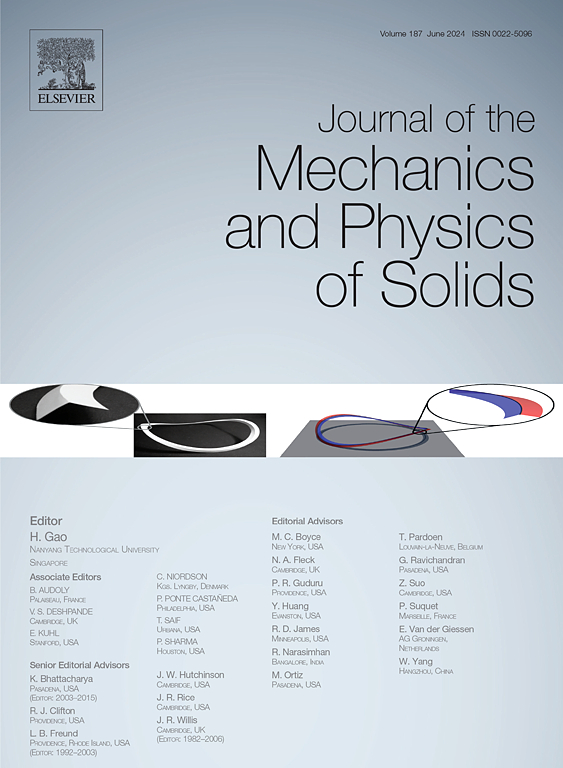Electromechanical buckling of periodic patterns on stiff film bonded to a compliant substrate – Analytical and numerical postbuckling analyses
IF 5
2区 工程技术
Q2 MATERIALS SCIENCE, MULTIDISCIPLINARY
引用次数: 0
Abstract
In this work, the analytical and numerical analyses of the electromechanical buckling and postbuckling states of a planar film bonded to a compliant dielectric substrate are presented. The film is a stiff thin metal layer and forms an elastic electrode. The compliant substrate is attached to a bottom fixed and rigid electrode. The film is simultaneously subjected to in-plane compression stresses, which can be induced by the thermal expansion mismatch effect, and to out-plane electrostatic traction that is induced by applying a voltage difference between the upper elastic electrode and the lower fixed electrode. Electromechanical buckling instability stems from the coupling of mechanical buckling instability and electromechanical pull-in instability and instigates mechanical buckling. This manuscript establishes an analytical approach to study the electromechanical critical and post buckling of one-dimensional, square checkerboard, hexagonal, and herringbone periodic buckling modes. Unlike previous works, in the current study the electrostatic traction and energy contributions are derived from the analytical solution of the electric potential function. A modified version of von-Karman plate equations are formulated and used along with the upper-bound energy method to derive analytical solutions for the critical and post electromechanical buckling states. The analytical critical and postbuckling solutions and energy state of periodic patterns are validated by a rigorous numerical finite element solution carried out in COMSOL Multiphysics. It has been found that the buckling stress and periodicity wavelength of a unit cell strongly depend on the applied voltage. The ability to manipulate the value of buckling stress by voltage increases the potential of applications in microsystem technologies such as electrical on/off switching of a surface wrinkling or deformable micromirror.
求助全文
约1分钟内获得全文
求助全文
来源期刊
CiteScore
9.80
自引率
9.40%
发文量
276
审稿时长
52 days
期刊介绍:
The aim of Journal of The Mechanics and Physics of Solids is to publish research of the highest quality and of lasting significance on the mechanics of solids. The scope is broad, from fundamental concepts in mechanics to the analysis of novel phenomena and applications. Solids are interpreted broadly to include both hard and soft materials as well as natural and synthetic structures. The approach can be theoretical, experimental or computational.This research activity sits within engineering science and the allied areas of applied mathematics, materials science, bio-mechanics, applied physics, and geophysics.
The Journal was founded in 1952 by Rodney Hill, who was its Editor-in-Chief until 1968. The topics of interest to the Journal evolve with developments in the subject but its basic ethos remains the same: to publish research of the highest quality relating to the mechanics of solids. Thus, emphasis is placed on the development of fundamental concepts of mechanics and novel applications of these concepts based on theoretical, experimental or computational approaches, drawing upon the various branches of engineering science and the allied areas within applied mathematics, materials science, structural engineering, applied physics, and geophysics.
The main purpose of the Journal is to foster scientific understanding of the processes of deformation and mechanical failure of all solid materials, both technological and natural, and the connections between these processes and their underlying physical mechanisms. In this sense, the content of the Journal should reflect the current state of the discipline in analysis, experimental observation, and numerical simulation. In the interest of achieving this goal, authors are encouraged to consider the significance of their contributions for the field of mechanics and the implications of their results, in addition to describing the details of their work.

 求助内容:
求助内容: 应助结果提醒方式:
应助结果提醒方式:


